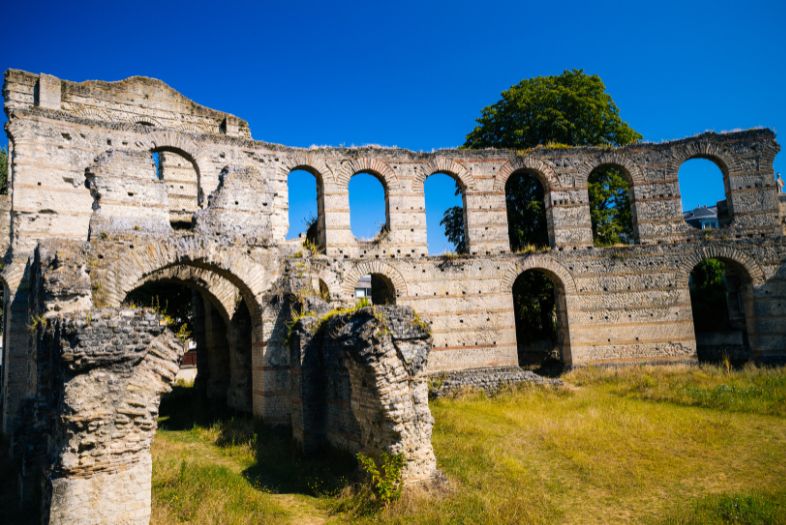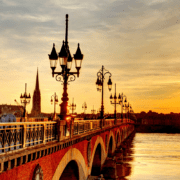
Palais Gallien: a legacy of Roman grandeur in Bordeaux
Have you ever wondered what life was like in Roman times? The Palais Gallien, another of Bordeaux’s attractions, offers you a journey back in time to discover it. This guide will take you around the corners of this historic site, revealing its secrets and the magnificence of its architecture.
We’ll also give you exclusive tips on how to make the most of your visit, which you’ll be able to make the most of with a free tour of Bordeaux. In this way, as well as being able to contemplate the beauty of the place, you will be able to learn some of the stories that only a few people know.
History of the Palais Gallien
This is a majestic Roman amphitheatre located right in the centre of Bordeaux. In fact, you will find it very close to Quinconces Square.
The Palais Gallien is a monument that has stood the test of time and today bears witness to the history of Bordeaux. Built in the 3rd century AD, this amphitheatre was erected during the period of splendour of the Roman Empire. At the time, Bordeaux (or Burdigala as it was then known), was a prominent Roman settlement.
It was designed as an amphitheatre to host gladiatorial fights, executions and other types of public entertainment, which were a vital part of Roman culture. With a capacity of 22,000 spectators, it reflects its original purpose of serving as an entertainment and meeting place for the inhabitants of Burdigala.
Evolution of the Palais Gallien
During Roman times, the Palais Gallien was a symbol of power and civilisation. It was a place where the community gathered not only for entertainment, but also to celebrate the greatness and power of the Roman Empire. Its construction and use demonstrated the importance of Burdigala as a key urban centre in Roman Gaul.
With the decline of the Roman Empire, it also underwent a gradual change. Over the centuries, it lost its original lustre and purpose, becoming a remnant that was partially forgotten and absorbed by the expanding city.
During the Middle Ages and in later times, parts of the amphitheatre were used as dwellings or as a quarry for building materials, thus altering its original structure. Despite these changes, however, the Palais Gallien has managed to retain a significant part of its original form and essence.
It was already used as a place of execution during the French Revolution.
Architecture and design of the Palais Gallien
Exploring the Palais Gallien is not only one of the most unusual things to do in Bordeaux. It is also an essential starting point for any excursion seeking to discover the history and architecture of the city. This amphitheatre, a remnant of Roman grandeur, offers a window into the past with its unique structure and innovative design.
Its elliptical design is characteristic of Roman amphitheatres, designed to accommodate a large crowd. As we have already mentioned, it is estimated that in its day it could hold up to 22,000 spectators for public events.
Although today only fragments of its original structure remain, these remains reveal much about its initial design.
- The tiers, arranged in a series of ascending levels, ensured that each spectator had an unobstructed view of the centre of the amphitheatre.
- The exterior façade, which at the time boasted a series of arches and elegant columns and statues, showed the influence of classical Roman architecture.
It was built with a design that favoured air flow and had an efficient drainage system to prevent flooding. The amphitheatre had multiple rooms, including a loggia, a storage area and a space for animals.
Innovations and unique features
One of the most remarkable features is its ability to have survived through the centuries in a city that has seen constant change and evolution. Unlike many other Roman monuments that were dismantled or destroyed, it has endured, albeit partially, offering a tangible testimony to Roman engineering.
It should also be noted that the Palais Gallien was not only used for entertainment as it was originally. Over time, it was adapted for a variety of uses, demonstrating the versatility and sustainability of its original design.
Interestingly, you might think that this place is located outside the city, as it was originally outside the city walls. No, the Palais Gallien is within the local boundaries, making excursions from Bordeaux to visit it unnecessary. It is an accessible destination within the city that offers visitors the opportunity to immerse themselves in history without leaving the city centre.ç
This place is an ideal starting point for those seeking to understand the rich history of Bordeaux and its evolution over the centuries.
The Palais Gallien in the Culture of Bordeaux
The Palais Gallien is a symbol of the city’s rich history and cultural identity. This Roman relic represents the tangible connection between the past and the present, showing the evolution of the city from its Roman origins to modernity.
Its architecture, though partially preserved, still evokes the impressive engineering and artistry of antiquity, allowing visitors and locals alike to connect with a bygone era, but one that still lives on in the city’s collective memory.
For visitors looking to explore this iconic site, it’s useful to know where to park in Bordeaux. However, this is a city that suggests getting to know on foot, as many of the sights, such as Bordeaux’s Palais Rohan, are relatively close by. This is another landmark that reflects the elegance and history of the city.
Although it is open every day, it is possible to arrange a tour where the history and evolution of this place will be better explained. You can even visit it at night every Saturday during the summer season.
Conservation and restoration of the Palais Gallien
Over the years, there have been significant efforts to preserve this important historical monument. These efforts have involved both the stabilisation of existing structures and the restoration of parts of the amphitheatre to reflect its original state.
One of the main challenges has been the balance between preserving the historic integrity of the site and adapting it for safe study and visitation by the public. Natural erosion, urbanisation and vandalism have presented additional obstacles to the preservation of the site.
Contributions to conservation have come from local institutions, such as the city government; and from French heritage organisations interested in world heritage preservation.
These collaborations have been important in ensuring that it survives as a reminder of Roman grandeur. They also aim to ensure that the Palais Gallien remains an integral part of Bordeaux’s culture and history.
These joint efforts underline the importance of the amphitheatre to the city and to the global community. They highlight how historical heritage can unite people and organisations around the world in a common goal.



